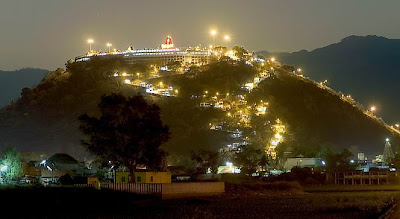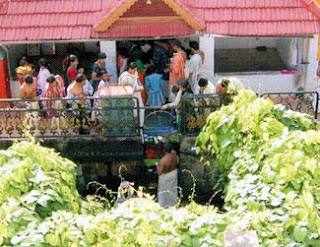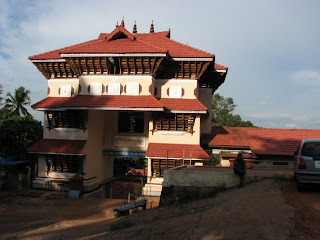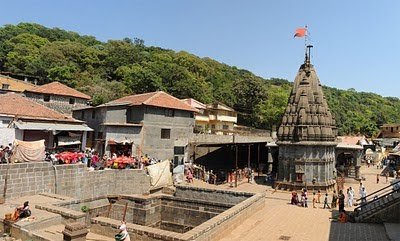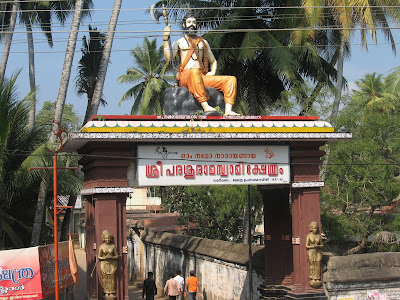Tripura Sundari Temple is situated about 20 km from Banswara
headquarters near Talwara village in Rajasthan. The presiding deity is Goddess Lalita Tripura Sundari (meaning the beauty of the three worlds) who is one of the forms of Goddess Shakti.
Popularly called as Matabari, Tripurasundari Temple in Rajasthan is
regarded as one of the 108 Shakti Peethas in India. Tripura Sundari is
called as Turtia Mata by the local people. According to mythology, Lord Vishnu cut the body of Goddess Sati into pieces by his Sudarshana Chakra.
These parts fell at different places which are known as Sakthi Peethas.
It is believed that the right foot of Sati fell at Matabari.
Tripura Sundari Temple Features
Situated atop a small hillock, the temple has a square type sanctum of the typical Bengali-hut style construction with a conical dome. The shrine was constructed by Maharaja Dhanya Manikya Debbarma in 1501 A.D. You can see two identical images of the same deity inside the temple. One is Chhotima which is around 2 feet in height and the other Tripura Sundari which is of 5 feet. Tripura Sundari Temple is also known as Kurma Pith because the shape of the temple is similar to that of tortoise (Kurma means tortoise).
The Goddess with eighteen arms is seen inside the sanctum on a lion statue. The idol is made of reddish black Kastic pathar. Shri Yantra (the symbol of Hindu tantra) is built at her feet. Tripura Sundari is so called because she is seen in her three different forms such as that of a lion, peacock and seated on a lotus, and appears as Kumarika, a young girl in the morning; as an attractive young- maid in the mid-day, and an adult woman in the evening. The backdrop of the main shrine is carved with the winter images of the nine Durga. There are also shrines dedicated to Hanuman which is seen at the entrance and Neeelkanth Mahadev at the backside. The Kalyan Sagar Lake in the eastern side of the temple adds to its beauty.
Festivals and Events
Chaitra Navratra Parv, Ashwin Navartri Parv, Kartiki Purnima, Shukla Paksh Asthmi and Shravan Mass are some of the notable events at the temple.
Temple Timings
The temple opens at 5.00 AM during summer and at 5.30 AM during winter. It is closed at 9.00 PM during summer and 8.30 PM during winter. Here the summer is considered from 1st March to 15th October and winter is from 16th October to 28th February.
How to Reach Tripura Sundari Temple Rajasthan
By Road
Tripura Sundari Temple is located about 55 km from Agartala, the capital city of Tripura, and 3 km from Udaipur which is the district Head-Quarter of the South Tripura district. National Highway 44 connects Tripura with many north- eastern states by road. Bus services are available from Silchar, Guwahati, Karimganj and Shillong.
Railway Station
The nearest railhead is Kumarghat on North-East Railway. It is 1475 km from Kolkata via Guwahati and 140 km from Agartala. Tourists can hire a taxi or take a bus to reach the temple.
The nearest airport is at Agartala.
Tripura Sundari Temple Features
Situated atop a small hillock, the temple has a square type sanctum of the typical Bengali-hut style construction with a conical dome. The shrine was constructed by Maharaja Dhanya Manikya Debbarma in 1501 A.D. You can see two identical images of the same deity inside the temple. One is Chhotima which is around 2 feet in height and the other Tripura Sundari which is of 5 feet. Tripura Sundari Temple is also known as Kurma Pith because the shape of the temple is similar to that of tortoise (Kurma means tortoise).
The Goddess with eighteen arms is seen inside the sanctum on a lion statue. The idol is made of reddish black Kastic pathar. Shri Yantra (the symbol of Hindu tantra) is built at her feet. Tripura Sundari is so called because she is seen in her three different forms such as that of a lion, peacock and seated on a lotus, and appears as Kumarika, a young girl in the morning; as an attractive young- maid in the mid-day, and an adult woman in the evening. The backdrop of the main shrine is carved with the winter images of the nine Durga. There are also shrines dedicated to Hanuman which is seen at the entrance and Neeelkanth Mahadev at the backside. The Kalyan Sagar Lake in the eastern side of the temple adds to its beauty.
Festivals and Events
Chaitra Navratra Parv, Ashwin Navartri Parv, Kartiki Purnima, Shukla Paksh Asthmi and Shravan Mass are some of the notable events at the temple.
Temple Timings
The temple opens at 5.00 AM during summer and at 5.30 AM during winter. It is closed at 9.00 PM during summer and 8.30 PM during winter. Here the summer is considered from 1st March to 15th October and winter is from 16th October to 28th February.
How to Reach Tripura Sundari Temple Rajasthan
By Road
Tripura Sundari Temple is located about 55 km from Agartala, the capital city of Tripura, and 3 km from Udaipur which is the district Head-Quarter of the South Tripura district. National Highway 44 connects Tripura with many north- eastern states by road. Bus services are available from Silchar, Guwahati, Karimganj and Shillong.
Railway Station
The nearest railhead is Kumarghat on North-East Railway. It is 1475 km from Kolkata via Guwahati and 140 km from Agartala. Tourists can hire a taxi or take a bus to reach the temple.
The nearest airport is at Agartala.







